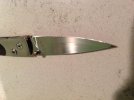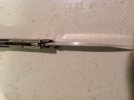Ernie1980
Gold Member
- Joined
- Apr 19, 2012
- Messages
- 8,162
I tried to sharpen my little William Henry knife this evening, with poor results. The blade is zdp-189. I tried to keep the factory angle , and sharpened with diamond hones followed by stropping. The blade is light saber sharp: but only half of it!
I think it is part me and part a design flaw. Why would William Henry made a knife with only a 2.5 in blade and not either sharpen the entire length or put in a sharpening notch??! From the factory only about 2/3 of the blade was sharp, I somehow made it worse
As you can see, in my efforts to fix it I created a wider bevil towards the handle but obviously never hit the apex.


What do you when you get a blade like this?
Thanks!!
I think it is part me and part a design flaw. Why would William Henry made a knife with only a 2.5 in blade and not either sharpen the entire length or put in a sharpening notch??! From the factory only about 2/3 of the blade was sharp, I somehow made it worse
As you can see, in my efforts to fix it I created a wider bevil towards the handle but obviously never hit the apex.


What do you when you get a blade like this?
Thanks!!
